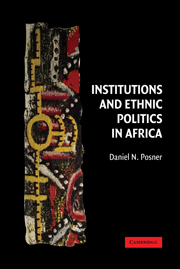Book contents
- Frontmatter
- Contents
- Preface
- INSTITUTIONS AND ETHNIC POLITICS IN AFRICA
- 1 Introduction
- I Introduction to Part I
- 2 Accounting for Zambia's Ethnic Cleavage Structure I
- 3 Accounting for Zambia's Ethnic Cleavage Structure II
- II Introduction to Part II
- III Introduction to Part III
- IV Introduction to Part IV
- Appendices
- Bibliography
- Index
- Titles in the series
3 - Accounting for Zambia's Ethnic Cleavage Structure II
The Emergence of Language Group Identities in Colonial Northern Rhodesia
Published online by Cambridge University Press: 05 June 2012
- Frontmatter
- Contents
- Preface
- INSTITUTIONS AND ETHNIC POLITICS IN AFRICA
- 1 Introduction
- I Introduction to Part I
- 2 Accounting for Zambia's Ethnic Cleavage Structure I
- 3 Accounting for Zambia's Ethnic Cleavage Structure II
- II Introduction to Part II
- III Introduction to Part III
- IV Introduction to Part IV
- Appendices
- Bibliography
- Index
- Titles in the series
Summary
Chapter 2 showed how the institutions of colonial rule – that is, the policies, rules, and regulations put in place by the Northern Rhodesian colonial administration and its mining company partners – created incentives for Africans to invest in their identities as tribesmen and tribeswomen. In this chapter, I show how a different set of colonial-era actions and policies caused Africans also to think about themselves and the territory's ethnic divisions in language group terms. In addition, just as Chapter 2 showed how colonial-era institutions were responsible for shaping the locations and relative sizes of tribal communities, this chapter accounts for the number, distribution, and dimensions of the groups that make up Zambia's contemporary linguistic landscape.
The chapter is divided into four parts. The first part shows how colonial-era institutions led to the consolidation of language use patterns from a situation where dozens of different vernaculars were in use to one where four major languages predominated. The second part explains how these institutions led Zambia's four broad linguistic communities to have the relative sizes that they do and to be physically located in the parts of the country that they are. Having accounted for the contours of the landscape of linguistic divisions, the third part of the chapter explains why Africans in Northern Rhodesia had incentives to embrace and define themselves in terms of their language communities, and thus why language matters for self-identification and group classification in Zambia today.
- Type
- Chapter
- Information
- Institutions and Ethnic Politics in Africa , pp. 56 - 88Publisher: Cambridge University PressPrint publication year: 2005



